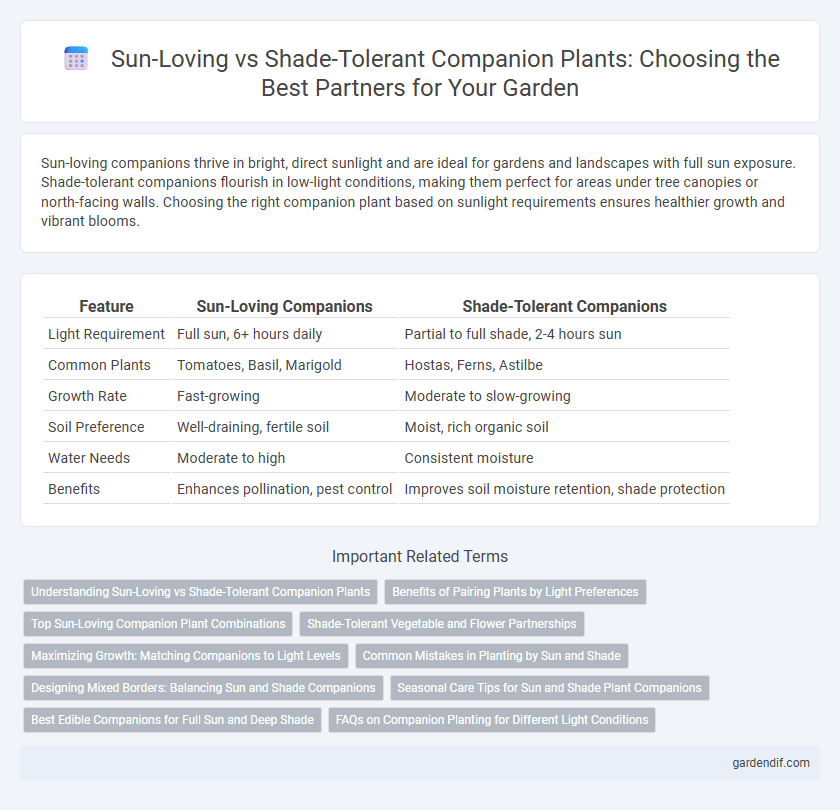
Sun-loving companions vs Shade-tolerant companions Illustration
Sun-loving companions thrive in bright, direct sunlight and are ideal for gardens and landscapes with full sun exposure. Shade-tolerant companions flourish in low-light conditions, making them perfect for areas under tree canopies or north-facing walls. Choosing the right companion plant based on sunlight requirements ensures healthier growth and vibrant blooms.
Table of Comparison
| Feature | Sun-Loving Companions | Shade-Tolerant Companions |
|---|---|---|
| Light Requirement | Full sun, 6+ hours daily | Partial to full shade, 2-4 hours sun |
| Common Plants | Tomatoes, Basil, Marigold | Hostas, Ferns, Astilbe |
| Growth Rate | Fast-growing | Moderate to slow-growing |
| Soil Preference | Well-draining, fertile soil | Moist, rich organic soil |
| Water Needs | Moderate to high | Consistent moisture |
| Benefits | Enhances pollination, pest control | Improves soil moisture retention, shade protection |
Understanding Sun-Loving vs Shade-Tolerant Companion Plants
Sun-loving companion plants thrive in full sunlight, requiring at least six hours of direct sun daily to maximize photosynthesis and growth, making them ideal for bright garden spots. Shade-tolerant companions adapt to lower light conditions by efficiently using limited sunlight, often flourishing under taller plants or in partially shaded areas, which helps create a diverse and balanced ecosystem. Understanding these light preferences ensures optimal plant pairing, improving garden health, pest control, and overall productivity.
Benefits of Pairing Plants by Light Preferences
Pairing sun-loving companions with shade-tolerant companions maximizes garden efficiency by optimizing photosynthesis according to each plant's light needs. Sun-loving plants thrive in full sunlight, enhancing growth and flowering, while shade-tolerant plants protect soil moisture and reduce temperature stress in lower light areas. This strategic pairing improves biodiversity, reduces water usage, and fosters a resilient garden ecosystem.
Top Sun-Loving Companion Plant Combinations
Sun-loving companion plants like marigolds, zinnias, and basil enhance growth by attracting pollinators and repelling pests while thriving in full sunlight environments. Combining sun-loving companions such as tomatoes with basil and nasturtiums maximizes garden productivity and pest control through natural synergy. These top sun-loving combinations improve plant health, flavor, and yield, making them ideal for gardens with abundant sunlight.
Shade-Tolerant Vegetable and Flower Partnerships
Shade-tolerant companions thrive in low-light conditions, making them ideal for gardens with limited sunlight. Vegetables like spinach and lettuce pair well with flowers such as impatiens and begonias, creating mutually beneficial growth environments that enhance soil nutrients and deter pests. These plant partnerships optimize space and promote healthy yields in shaded garden areas.
Maximizing Growth: Matching Companions to Light Levels
Sun-loving companions such as tomatoes and basil thrive in full sunlight, maximizing photosynthesis and boosting overall growth rates when planted together in well-lit areas. Shade-tolerant companions like ferns and hostas optimize growth by efficiently utilizing lower light levels under tree canopies or shaded garden spots. Matching these plants to their ideal light environments enhances nutrient uptake, reduces competition, and supports robust development in mixed garden settings.
Common Mistakes in Planting by Sun and Shade
Sun-loving companions commonly suffer from inadequate light when planted in shaded areas, leading to stunted growth and poor flowering. Shade-tolerant companions often experience leaf scorch and dehydration if placed in direct sunlight for prolonged periods. Proper site assessment and matching plants to their light requirements prevents these common planting mistakes and ensures healthy, thriving companions.
Designing Mixed Borders: Balancing Sun and Shade Companions
Designing mixed borders requires selecting sun-loving companions such as lavender, salvia, and echinacea alongside shade-tolerant companions like hostas, ferns, and astilbes to create a balanced, vibrant garden. Placing sun-loving plants in areas with at least six hours of direct sunlight ensures optimal growth and flowering, while shade-tolerant plants thrive in dappled or full shade, enhancing texture and depth. Careful spatial arrangement and soil moisture management harmonize these diverse companions, maximizing visual appeal and plant health.
Seasonal Care Tips for Sun and Shade Plant Companions
Sun-loving companions thrive in full sunlight and require regular watering during peak summer months to prevent drought stress. Shade-tolerant companions demand less frequent watering and benefit from mulching to retain soil moisture and regulate temperature. Seasonal care for both includes adjusting fertilization levels; sun-loving plants often need more nutrients in spring and summer, while shade-tolerant varieties require minimal feeding throughout the year.
Best Edible Companions for Full Sun and Deep Shade
Best edible companions for full sun include tomatoes, peppers, and basil, which thrive in bright, direct sunlight and enhance each other's growth through natural pest repellence and nutrient exchange. For deep shade, leafy greens like spinach, kale, and chicory perform well, adapting to lower light while providing vital nutrients and flavor in shaded garden spots. Selecting companions based on sun exposure optimizes edible yields and promotes healthier plant development in diverse garden microclimates.
FAQs on Companion Planting for Different Light Conditions
Sun-loving companions thrive best in full sunlight, enhancing growth and yield when paired appropriately with other sun-preferring plants like tomatoes and basil. Shade-tolerant companions excel in low-light environments, making them ideal for shaded garden areas and improving under-canopy plant health, such as lettuce and spinach. Understanding specific light requirements and matching companions accordingly prevents competition and promotes optimal plant health and productivity.
Sun-loving companions vs Shade-tolerant companions Infographic

 gardendif.com
gardendif.com